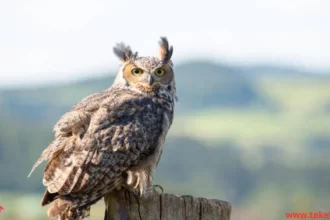Below we review more about the hornbill, how it lives and feeds, and we list the most important facts that distinguish it.
In this Article about Hornbill bird in TekeTrek Website, we will introduce you to the most important information related to this object. Follow along with us.

About Hornbill bird
The hornbill is an animal from the Bucerotidae family, which includes 60 species of tropical birds in the Coraciiformes order:
- It has a prominent beak topped with a bony helmet in some species.
- It has a large head, thin necks, broad wings, and long tails. Its feathers are brown or black, with dark white markings.
- Its length ranges from 40 cm in the tocos to 160 cm in the large (Buceros bicornis) due to its extended tail feathers, the helmeted hornbill.
- It weighs 99.1 grams and is 32 cm long, but its average weight is 3.77 kg, and may reach 6.3 kg. Males are larger than females.
- Some species (B. rhinoceros) have a brightly colored beak and operculum resulting from rubbing against the gland under the tail, which stimulates the production of an orange-red oily fluid that adds a reddish colour.
Hornbill habitats
Hornbills are found in tropical and subtropical regions of Africa, Asia, Melanesia, sub-Saharan Africa and the Indian subcontinent to the Philippines and the Solomon Islands.
- It lives in cavities in large trees, but some are terrestrial (Bucorvus). It lives in open savannas.
- The males plug the walls of the nest, closing the hole with mud, leaving a small slit for food to pass through. After the eggs hatch, the female emerges, but the young may remain attached.
- The hornbill is a diurnal bird, traveling in pairs or small family groups.
- Larger herds form outside the breeding season.
- Groups form at their roosting sites, and you will find about 2,400 individual birds.
Food for hornbills
The hornbill is a carnivorous bird, feeding on fruits, insects and small animals.
- The female great hornbill feeds on fruits such as figs.
- They cannot swallow food caught at the tip of the beak because their tongues are too short to handle it, so they throw it back into the throat with a shake of the head.
- Fruit-eating hornbills are found in forests, while carnivores are found in open areas.
- Hornbills in forests are considered one of the most important sources of seed dispersal.
Reproduction in hornbills
Hornbills form monogamous pairs, and some species engage in cooperative breeding.
- The female lays six white eggs in holes or crevices.
- Nesting sites are used in several successive breeding seasons for the same pair.
- Before incubation, Bucerotinae females help the male seal the entrance to the nest cavity with a mud wall and fruit pulp.
- When the female prepares to lay eggs, the entrance is sufficient for them to enter, then she closes it, leaving a small opening for food to enter, and she lays her eggs within five days.
- It lays one to two eggs, and eight eggs in the larger species.
- During the incubation period the female undergoes a complete and simultaneous molt, in which the darkness of the cavity stimulates a hormone involved in molting.
- After the chicks grow up, the mother breaks the nest, and both parents feed them.
- Then the female rebuilds the wall, and in some species the chicks build it.

Interesting facts about hornbills
Among the most prominent facts about Abu Al-Qarn:
- Some species, such as the crested (T. alboterminatus) of South Africa and the bushy-crested hornbill (Anorrhinus galeritus) of Southeast Asia, have large populations and ranges.
- The hornbill in Africa has a mutual relationship with the dwarf mongoose. They search for food together and warn each other of predators. It is also associated with monkeys for eating insects that they repel.
- Its large beak helps it fight, prepare, build the nest, and hunt prey.
- The hornbill is distinguished by its cusp, which is a hollow structure that extends along the upper lower jaw. But in some species it enhances the beak, while in others it is large and reinforced with bone, and has openings between the hollow center that allow it to function as a resonator for calls.
Hornbills and extinction
Hornbills are not considered endangered, according to the International Union for Conservation of Nature (IUCN), but some species are threatened by deforestation and hunting pressures:
- (Penelopides Mindorensis) is limited to Mindoro Island in the Philippines.
- The Visayan (P. panini) is endemic to and around Panay Island and is threatened.
- (Anthracoceros montani) and Aceros waldeni) are classified as critically endangered.
FAQ
The most common questions about the hornbill:
- Where do you find hornbills?
It inhabits cavities in large trees, but Bucorvus is terrestrial and inhabits open savannas.
- How do hornbills reproduce?
Hornbills reproduce by laying eggs, with the female laying one or two eggs in small species, while large species lay 8 eggs.
- Are hornbills rare? in danger of extinction?
Hornbills are not listed on the Red List of Threatened Species, but some of them (Penelopides mindorensis), Visayan (P. panini), (Anthracoceros montani) and Aceros waldeni) are threatened with extinction.
- What does the hornbill bird symbolize?
It symbolizes to good luck.
In short, the hornbill is a diurnal carnivorous bird that reproduces by laying eggs. Some species are threatened with extinction and others are not.






